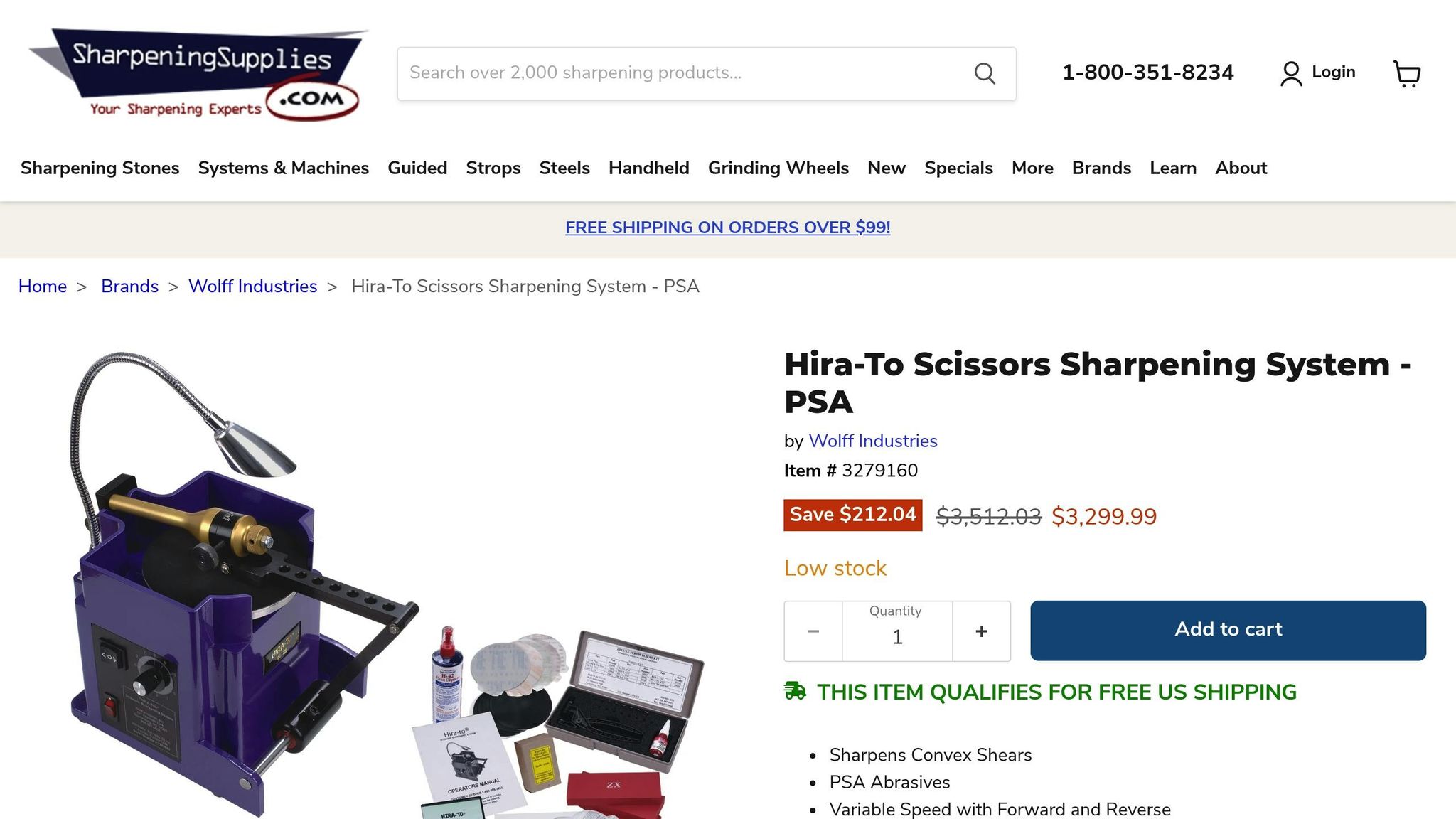Your professional hair shears are essential for delivering precise, high-quality cuts. Proper maintenance ensures they stay sharp, last longer, and protect your investment. Here's a quick guide to keep your shears in top condition:
- Daily Cleaning: Wipe blades after each use with isopropyl alcohol to remove hair and debris. Dry thoroughly to prevent moisture damage.
- Weekly Deep Cleaning: Soak shears briefly in warm, soapy water, clean the pivot area, and dry completely. Apply shear oil to reduce friction and protect against rust.
- Sharpening: Sharpen every 3–6 months, or sooner if cuts feel dull or uneven. Use professional services for high-end Japanese steel shears to maintain their precision.
- Storage: Store shears in a dry, protective case with silica gel packets to avoid rust and accidental damage.
How To Use the Hira-To Sharpening System for Professionals | Scissor and Shear Sharpening

Daily and Weekly Maintenance Practices
Keeping your shears in top condition requires a regular care routine. Not only does this ensure precision with every cut, but it also protects the longevity of your investment.
"It is important to clean your scissors every day in order to remove any buildup or debris that may have accumulated during use." - James Adams
How to Clean Your Shears
Daily cleaning is a simple but crucial step to prevent buildup and keep your blades performing at their best. Here’s how you can maintain your shears:
- Daily cleaning: After each use, wipe away hair and debris from the blades. Disinfect both blade surfaces with isopropyl alcohol using a paper towel, and make sure to dry them thoroughly to avoid moisture-related damage.
- End-of-day routine: At the end of the day, clean the blades again with rubbing alcohol. Use a toothpick to clear out the pivot area, where hair and residue often get trapped. Sanitize the blades one more time before applying a few drops of shear oil.
- Weekly deep cleaning: Once a week, soak your shears in warm, soapy water for about a minute to loosen any stubborn buildup. Wipe them clean with a soft cloth and dry completely with a lint-free towel to prevent rust.
| Step | Action | Purpose |
|---|---|---|
| Deep Clean | Wipe blades with rubbing alcohol | Removes stubborn residue |
| Pivot Area | Clear with a toothpick | Removes trapped debris |
| Lubricate | Apply shear oil | Maintains smooth operation |
Applying Oil for Smooth Operation
Oiling your shears is essential to prevent rust, reduce friction, and maintain their cutting precision. For average use, oil your shears at least once a week. If you use them heavily every day, consider oiling them daily.
To apply oil:
- Hold the shears with the tips pointing downward at a 45-degree angle.
- Place two drops of scissor oil at the pivot point.
- Open and close the shears several times to evenly distribute the oil.
- Let the oil sit overnight to penetrate, then open and close the blades again in the morning to flush out any loosened debris. Wipe away any excess oil.
Oiling not only maintains smooth operation but also creates a protective barrier against potential damage from hair, styling products, or chemicals.
Storage Methods That Protect Your Shears
Proper storage is just as important as cleaning and oiling. Always store your shears in a case or tool roll to protect them from dust, moisture, and accidental drops. Before putting them away, ensure they are completely dry, check the tension, and store them separately to avoid blade contact, which can cause dulling.
For additional protection:
- Keep your shears in a dry, stable environment, away from heat sources that could cause misalignment.
- Add silica gel packets to your storage case to absorb excess moisture.
Shihan Shears offers several storage options to suit your needs:
- Compact 10-Piece Case: $75.00
- Luxury 10-Piece Case: $150.00
- Émile Shear Purse: $250.00
- Nabukku Shear Case: $250.00
"Professional shears are an investment for stylists, one of the most used and expensive tools in the bag, so prolonging optimal performance is a priority." - Sam Villa
How to Sharpen Professional Shears
Keeping your professional shears sharp is essential for precise cutting and extending their lifespan.
Tools You Need for Sharpening
The right tools make all the difference when it comes to sharpening. High-quality sharpening stones or systems are a must, and the best option depends on the type of steel your shears are made from. For shears with a convex edge, specialized tools are necessary to maintain their curved profile. Professional shear sharpening machines are also available, with prices ranging from $10 to $3,600. For premium steel shears, many experts recommend opting for professional sharpening services to achieve the best results. Before investing in equipment, take time to research what works best for your specific shears and their construction.
Once you have the right tools, you can follow a systematic approach to bring your shears back to peak performance.
Step-by-Step Sharpening Process
Sharpening shears professionally involves a series of precise steps. In 2025, Scissor Warrior outlined a method that includes inspection, sharpening with a whetstone, convex honing, hand-polishing, and tension adjustment to ensure proper alignment.
Start by inspecting your shears for wear, micro-chips, misalignment, or improper tension before beginning the sharpening process.
1. Whetstone Sharpening:
Begin by wetting the whetstone with clean water. Lay the blade flat on the stone with the cutting edge facing down. Apply light pressure and make 15–20 strokes per side. Once finished, rinse both the whetstone and the blade, then gently clean the blade with a damp paper towel. Test the sharpness by cutting a small section of hair.
2. Convex Honing and Polishing:
Use specialized tools for convex honing to refine the blade’s curved edge. Follow up with hand-polishing to eliminate micro-imperfections and finalize the tension and alignment.
"Great shears deserve great care. Our sharpening process is more than just maintenance - it's a detailed craft that restores the performance, beauty, and longevity of your professional tools. By combining tradition with precision, we make sure your shears deliver the same smooth, clean cut as the day you bought them - if not better." - Scissor Warrior
When to Sharpen Your Shears
Knowing when to sharpen your shears is just as important as knowing how. Typically, high-quality shears need sharpening every 3–6 months. However, if you’re working in a busy environment like a barber shop, you may need to sharpen them more often. Signs that your shears need attention include:
- A dull or dragging feel when cutting
- Difficulty achieving clean, straight lines
- Hair splitting or folding instead of cutting smoothly
If your shears are dropped, even if they were recently serviced, they should be professionally sharpened to restore their performance.
To keep your shears in top shape between sharpening sessions, clean and oil them regularly. This simple maintenance step can go a long way toward preserving their cutting precision and extending their lifespan.
sbb-itb-a50b05d
Caring for Premium Japanese Steel Shears
Japanese VG-10 and ATS-314 steel shears are renowned for their precision and durability, but they need specific care to maintain their cutting edge and resist corrosion. These high-performance materials require handling techniques tailored to their unique properties.
Special Care for Japanese Steel
Shears made from Japanese VG-10 and ATS-314 steel demand a different level of care compared to standard stainless steel scissors. These steels are crafted to meet strict metallurgical standards in Japan.
One of the most important factors to consider is moisture control. While Japanese steel resists rust better than lower-grade alternatives, moisture is still its number one enemy. After every use, wipe the shears with a microfiber cloth to remove hair, residue, and any moisture. This simple step prevents buildup and corrosion.
For daily disinfection, use a spray disinfectant or a barbicide solution specifically designed for hairdressing tools. Avoid soaking the shears in liquid disinfectants, as prolonged exposure can damage the steel's surface. Instead, spray the disinfectant directly on the blades and wipe them clean with a microfiber cloth.
Weekly cleaning should focus on the pivot area, where hair and debris often collect. Use a scissor brush or compressed air to clear out any buildup. Once a month, clean between the blades with alcohol and a brush. However, don’t overuse alcohol-based cleaners, as they can dry out the metal and make it brittle over time.
Lubrication is another critical step. Apply scissor oil to the pivot area at least once a week to ensure smooth operation. The hardness of Japanese steel means these shears don’t need sharpening as often, but regular oiling is key to maintaining their performance.
"Proper shear cleaning, sanitization, and storage are crucial for maintaining sharpness, performance, and longevity." - Scott Wilson, Salon Shears Direct
By following these care steps, you can extend the lifespan of your shears and keep them performing at their best.
How to Spot Signs of Wear
Japanese steel shears show wear differently than lower-quality scissors, and catching issues early can save you from costly repairs or replacements.
Start by looking for physical damage, such as nicks on the cutting edge, bent tips, or visible scratches. Dropping your shears can cause misalignment, which is particularly problematic for precision-engineered Japanese steel.
Pay attention to performance issues as well. If the shears drag instead of cutting cleanly or if hair starts bunching instead of sliding smoothly through the blades, it’s a sign they may need servicing.
Check for corrosion and surface problems, like rust spots, discoloration, or a dull blade surface. Even though Japanese steel is more resistant to corrosion, improper storage or prolonged exposure to moisture can still cause damage. Be sure to inspect the pivot area regularly, as it’s a common spot for debris and moisture buildup.
Finally, watch for tension problems. Uneven or stiff blade movement might indicate over-tightening of the pivot screw, which can strain the blades. The blades should move smoothly without wobbling or binding.
Recognizing these wear indicators helps you decide when sharpening or repairs are necessary.
Professional vs. At-Home Sharpening Options
When it comes to sharpening Japanese steel shears, the choice between professional services and at-home maintenance is an important one. These shears are precision tools, and their convex edges require expert care to maintain their cutting geometry.
Professional sharpening services use specialized tools and techniques designed specifically for high-end scissors. This ensures the entire blade is sharpened correctly, preserving its engineered curve. The complexity of convex edges makes professional sharpening the safer option, especially for expensive shears.
At-home sharpening can work for basic upkeep, but it requires knowledge, practice, and the right tools. Without proper technique, you risk damaging the blade. A single mistake could ruin shears that cost hundreds of dollars.
For best results, many experts recommend professional sharpening every 3–6 months, paired with consistent daily maintenance to keep your Japanese steel shears in peak condition.
Shihan Shears: Product Care Recommendations

Each Shihan Shears model is designed with precision and durability in mind, but proper care is essential to maintain their performance. Following the specific care instructions for your shears will help extend their lifespan and ensure they continue to deliver the cutting quality you rely on.
Care Tips for Each Shihan Shears Model
Legacy Hair Shears Set
Crafted from high-grade ATS-314 steel, this set includes 6.8‑inch cutting scissors and 6‑inch thinning shears. After every use, clean both tools with rubbing alcohol and a cotton ball, focusing on the blades. Once cleaned, apply a thin layer of oil to the edges and store them in their leather case overnight.
Red Moon Hair Shears Set
Made from VG-10 stainless steel, these shears are sensitive to moisture. After use, thoroughly dry the 5.5‑inch cutting shear and 6‑inch thinning shear to prevent rust or dulling. Store each tool in its individual compartment to avoid contact with other metal surfaces.
Zen Hair Cutting Shears
For the 6.0‑inch VG-10 steel blades, apply a small amount of oil between the blades while they are open. Spread the oil across the cutting edges and flat sides, ensuring even coverage. This helps push dirt and hair away from the screw area, keeping the shears in optimal condition.
Meister Hair Cutting Shears
These 5.75‑inch precision shears require regular tension checks. Monitor the screw tension closely, as improper adjustments can misalign the blades. If you notice frequent tension changes, it may indicate internal wear that should be addressed by a professional.
Kaicho Hair Cutting Shears
For these 6‑inch cutting shears, apply oil at the pivot point and let it sit overnight. The next morning, open and close the shears while holding them downward to flush out any hair buildup. Wipe them clean before storing.
Always store your shears in their designated leather cases in a cool, dry place to protect them from damage and environmental factors.
Getting the Most from Your Shihan Shears
Daily maintenance is key to keeping your Shihan Shears in top condition. Cleaning and oiling after each use help prevent residue buildup from hair and styling products, which can compromise performance. Proper lubrication ensures smooth operation, reducing strain on your hands during extended use.
In addition to daily care, periodic professional servicing is essential. Regular sharpening every 3–6 months will maintain their cutting precision. Combined with your daily routine, this ensures your shears stay sharp and reliable. With a lifetime warranty backing every model, these care practices protect your investment and ensure your tools perform like new for years to come.
Conclusion: Proper Care for Long-Lasting, Precise Shears
Taking care of your professional hair shears is more than just preserving a tool - it's about protecting your investment and delivering consistent, high-quality results for every client. The secret to their longevity lies in building good daily habits and knowing when to rely on expert sharpening services.
Simple routines like cleaning your shears after every use and applying shear oil to the pivot keep them operating smoothly. Regular tension checks and adjustments ensure the blades stay aligned, preventing issues like hair folding. And don’t overlook proper storage - keeping your shears in their designated case can prevent unnecessary wear and tear.
Professional sharpening, done at the right intervals, is another key to maintaining precision. Combine this with using your shears exclusively for cutting hair, and you’ll significantly extend their lifespan while preserving their performance.
Whether you use VG-10 or ATS-314 models, these care practices help you get the most out of your tools. Shihan Shears’ lifetime warranty is a testament to their durability, but proper care is what truly ensures they remain a reliable partner in your craft for years to come.
FAQs
How often should I oil my professional hair shears to keep them working smoothly?
To keep your professional hair shears in top condition, make it a habit to oil them once a week. This regular maintenance helps minimize friction, guards against rust, and keeps the blades moving smoothly.
After cleaning your shears, place a drop of high-quality shear oil on the pivot point. Then, slowly open and close the blades to spread the oil evenly. This quick and easy step can go a long way in preserving their sharpness and extending their overall lifespan.
How can I tell if my professional hair shears need sharpening?
If your shears aren’t cutting as smoothly or precisely as they used to, it’s probably time to sharpen them. Look out for signs like uneven cuts, hair pulling or snagging, or the blades feeling rough or dull while in use. You might also spot small nicks or dents along the edges or find that your shears are causing split ends instead of delivering clean, sharp cuts.
Regularly checking your shears and addressing these issues right away is key to keeping your tools in top shape and ensuring your work remains flawless.
How can I protect my hair shears from rust and moisture damage?
To ensure your hair shears stay in excellent condition, store them in a dry, climate-controlled space, far from humidity. Adding silica gel packets to your storage case can help absorb any excess moisture. After every use, make it a habit to wipe the blades clean with a dry cloth. Steer clear of storing your shears in humid spots, like bathrooms, as this can cause rust and long-term damage. These easy precautions can go a long way in maintaining the quality and lifespan of your shears.

